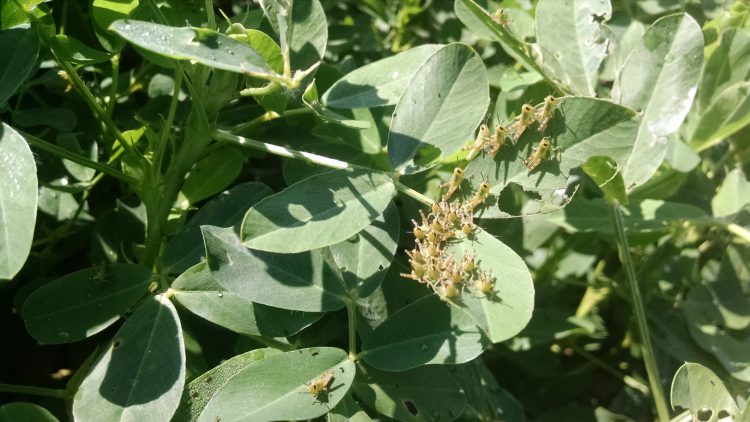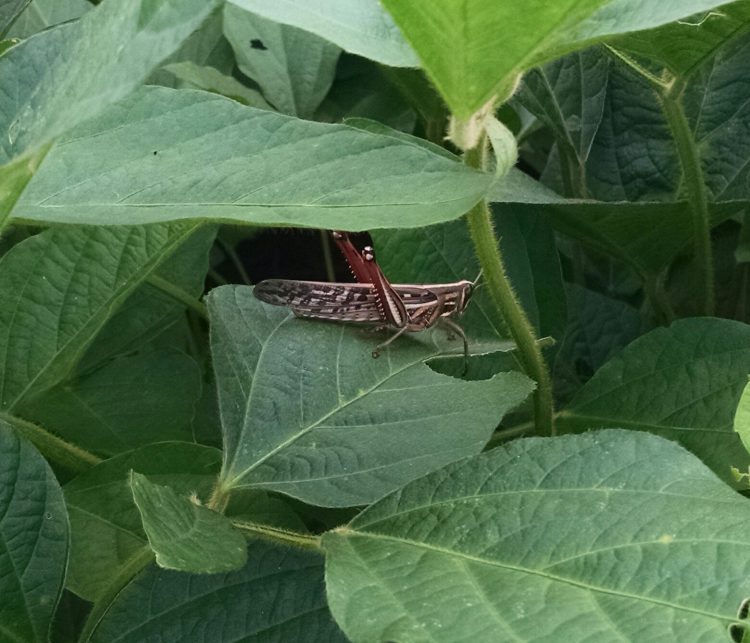–
Jennifer Bearden, UF/IFAS Okaloosa Extension Ag Agent, and Ethan Carter, Regional Crop IPM Agent
The warm, dry weather this spring is a serious concern. It’s causing many problems ranging from delayed planting to wildfires and everything in between. It is also causing grasshopper populations to become extremely high. Although grasshoppers are not a pest we normally focus on, their large numbers this spring warrant scouting.
Grasshoppers produce one generation per year. They lay their eggs in the fall by depositing them into the soil. Most grasshopper eggs overwinter in the soil. They hatch in the spring when soil temperatures and conditions are right. Nymphs start feeding immediately when hatched. They eat and grow through five instars before reaching adulthood. Different species hatch at different times depending on conditions. Nymphs are very susceptible to weather, disease and predators. Adequate rainfall during the nymph stage can cause grasshopper populations to decrease significantly.
Grasshoppers eat many types of plants. They have favored plants, but will eat most plants if necessary. Grasshoppers can eat up to 50% of their body weight each day. With higher than normal populations, that can lead to significant crop damage.
Scout for grasshoppers to determine if they are above thresholds. Count the number of grasshopper adults and nymphs in 18 different 12″ x 12″ squares in random locations throughout the field (don’t just walk the edges). Divide the total number of grasshoppers counted by two to get the average number of grasshoppers per square yard. For forages, USDA established the threshold of 15-20 nymphs or 8-10 adults per square yard. UGA’s recommended threshold for grasshoppers in soybean – prior to bloom, treat when 30% foliage loss has occurred and grasshoppers are present, or post bloom, when 15% of foliage loss has occurred and grasshoppers are present.
Adult grasshoppers are highly mobile in crops and can re-infest soon after treatment. Many of the more common insecticides used to treat grasshoppers are pyrethroids. which are generally more effective on nymphs than adults.
–
–
Grasshoppers can be found feeding on all row crops, but are managed more heavily in some crops than others. They are generalist feeders, often found on grass and weeds, but move into crop fields as weeds senesce or during dry conditions. Control is not usually an issue, but their populations have periodic outbreaks, usually during drought years or following a drought. Like most pests, grasshoppers are more easily controlled during the early (nymph) stage of their life cycle. To help with identification, nymphs do not have wings, while most species of adult grasshoppers have wings.
An example reference for grasshopper management in crops is included below. Note other options are available by site location (especially pyrethroids), as this is not an exhaustive list.
Forages |
|||
| Insecticide | MOA | Rate per acre | Notes |
| Malathion | 1B | 20oz. | |
| Cyfluthrin | 3A | 2.6-2.8oz. | |
| Lambda-cyhalothrin | 3A | 1.28-1.92oz. | |
| Carbaryl | 1A | 1-1.5qt. | |
| Zeta-cypermethrin | 3A | 2.24-4oz. | |
Corn |
|||
| Insecticide | MOA | Rate per acre | Notes |
| bifenthrin (Bifenthrin, Capture, etc.) | 3A | 2.1-6.4 fl oz | |
| cyfluthrin (Tombstone) | 3A | 2.1-2.8 fl oz | |
| esfenvalerate (Asana) | 3A | 5.8-9.6 fl oz | |
| lambda cyhalothrin (Warrior) | 3A | 1.28-1.92 fl oz | |
| zeta-cypermethrin (Mustang Maxx) | 3A | 3.2-4 fl oz | |
Cotton |
|||
| Insecticide | MOA | Rate per acre | Notes |
| acephate (Orthene) | 1B | 0.75 lb | |
| esfenvalerate (Asana) | 3A | 5.8-9.6 fl oz | |
| Malathion (Malathion ULV) | 1B | 8 fl oz | |
| zeta-cypermethrin (Mustang Maxx) | 3A | 3-4 fl oz | |
Peanut |
|||
| Insecticide | MOA | Rate per acre | Notes |
| acephate (Orthene) | 1B | 0.5 lb | |
| bifenthrin (Brigade) | 3A | 2.1-6.4 fl oz | |
| chlorantraniliprole (Prevathon) | 28 | 8-20 oz | |
| lambda-cyhalothrin (Karate) | 3A | 1.28- 1.92 fl oz | |
| novaluron (Diamond) | 15 | 9-12 oz | Nymph suppression |
| zeta-cypermethrin (Mustang Maxx) | 3A | 3.2-4 fl oz | |
Soybean |
|||
| Insecticide | MOA | Rate per acre | Notes |
| acephate (Orthene) | 1B | 0.5 lb | |
| bifenthrin (Brigade) | 3A | 2.1-6.4 fl oz | |
| lambda-cyhalothrin (Warrior II Zeon) | 3A | 1.6-1.92 oz | |
| zeta-cypermethrin (Mustang Maxx) | 3A | 3.2-4 oz | |
- 2023 WFREC Crop Variety Trial Results - February 2, 2024
- Hoof Care for Florida Horses - July 28, 2023
- Targeted Nutrient Management for Fruits and Vegetables - February 3, 2023


